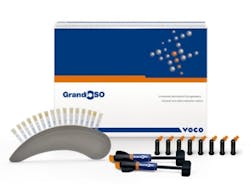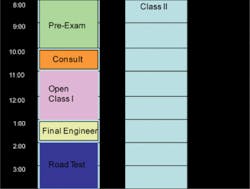Scheduling for success
by Mark Absher
For more on this topic, go to www.dentaleconomics.com and search using the following key words: scheduling, block scheduling, Class I, Class II, preblocking, Mark Absher.
There are three ways to increase a dentist’s productivity — work more hours, charge higher fees, or work more efficiently. Over the past 30 years I have learned that working more hours can burn out the dentist and team and make them less efficient, and fees that are too high can turn potential patients away in a competitive market. While the number of hours we work and fees we charge are worth investigating, working more efficiently provides the most bang for the buck. There is no area where this is truer than with our daily schedules.
Our office has developed a simple and effective method to help ensure scheduling success and improved profitability. First, we categorize all of our procedures into Class I or Class II. It’s up to each of you to determine which procedures are designated Class I or Class II, but we define Class I as our high income or high potential producing procedures, and Class II as our potential less income procedures.
Class I procedures include preps, seats, restorative, removable, comprehensive exams, final engineering, interview and initial exam, and consultation.
Class II procedures, while necessary, are difficult to charge a very high fee and in some cases are done at no charge. Some Class II procedures can be done by an auxiliary staff person.
Class II procedures include re-cement, toothache, hygiene exam, bleaching, bite adjustment, deliver bite appliance, bonding repair, office visit, and X-ray.
Divide your daily schedule into two columns. In the first column place only Class I procedures, and in the second column place only Class II procedures.
The only other scheduling rule to remember is that all Class II procedures are scheduled for one hour and there can be only one Class II procedure per hour. A typical schedule might look like this:
Block scheduling
To further enhance our ability to schedule for success we have found that preblocking our schedule is helpful. Complex restorative and cosmetic dentistry usually involves multiple teeth and requires appointments of anywhere from four hours to eight hours in duration. When a patient is motivated and ready to proceed with treatment, having an available appointment within a reasonable amount of time is very important.
In our office, at least one appointment per month is reserved that is eight hours long. If there are no eight-hour procedures to appoint within two weeks of the preblocked appointment, it is then opened for shorter duration Class I appointments. Again, it is up to each office to determine the frequency and duration of any preblockings. The preblocked schedule would appear like the example at the top of this article’s second page.
Another important preblock procedure for us is the initial interview and examination of a new patient. In our practice this Class I procedure is known as a pre-exam and is given a two-hour time slot.
Establishing a good relationship with new patients is critical to success, and selecting prime times on your schedule is key. We have found that the first appointment in the morning (8 a.m.) and our last appointment in the afternoon (2 p.m.) work well. We are always on time in the morning, and in the afternoon we can run over if necessary.
Devoting quality uninterrupted Class I time to new patients will provide great dividends. In addition to preblocking new patient slots, we also block consults, road tests, final engineering, and comprehensive exam appointments.
Again, if these pre-blocked appointments are not filled within two weeks, they are thrown back into the open Class I pool appointments. An example of our preblocked schedule looks like this:
Conclusion
Having a busy day does not necessarily mean having a successful and profitable schedule. If we allow our schedule to be filled with Class II procedures, this can certainly become the case. When creating your dream schedule of success, there are only a few simple rules to remember:
• Divide schedule into Class I and Class II columns
• Determine your Class I and Class II procedures
• Fill the Class I column with high potential productive procedures only
• Limit Class II procedures to one per hour
• Preblock long appointments and new patient time slots
• Remove preblocking if not filled within two weeks
The “scheduling for success” system is simple and very effective in helping to ensure profitability. Designating Class I and Class II procedures, along with preblocking important procedures, will become the preplanned destiny of your practice.
Mark Absher, BS, has been office manager and marketing director in the Arlington, Texas dental practice of his wife, Dr. Susan Hollar, since 1982. Prior to that he was a systems analyst and computer programmer, where he designed and implemented many successful business systems. He is devoted to dental practice management, Web site design, and digital photography. Absher is co-owner of DentalOptimization, a Web site development company catering exclusively to restorative and cosmetic dentists. Absher can be reached at [email protected].




